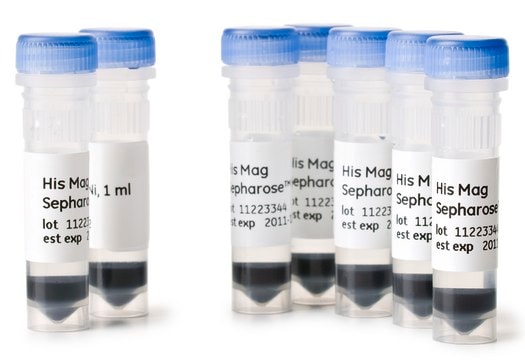A6861
Acetyl-CoA carboxylase 2 human
recombinant, expressed in Sf9 cells
Sinónimos:
ACACB, ACC2, acetyl-CoA carboxylase beta
Iniciar sesiónpara Ver la Fijación de precios por contrato y de la organización
About This Item
Productos recomendados
Application
Acetyl-CoA carboxylase is responsible for synthesis of Malonyl-CoA which is an inhibitor of fatty acid oxidation in skeletal muscle mitochondria. The enzyme may be used to study the effect on production of malonyl-CoA as well as fatty acid oxidation during exercise. The enzyme also may be used for ACC regulation study in anti-obesity and anti-type 2 diabetes therapeutics.
Biochem/physiol Actions
Acetyl-CoA Carboxylase (ACC) regulates the metabolism of fatty acids. This enzyme catalzes the formation of Malonyl CoA through the irreversible carboxylation of acetyl CoA. There are two main isoforms of Acetyl-CoA carboxylase expressed in mammals, Acetyl-CoA carboxylase 1 (ACACA) and Acetyl-CoA carboxylase 2 (ACACB). ACACA has broad tissue distribution but is enriched in tissues critical for fatty acid sythesis such as adipose tissue. ACACB is enriched in tissues such as skeletal muscle and heart that are critical for fatty acid oxidation.
The Acetyl-CoA Carboxylase enzymes are activated by citrate, glutamate, and dicarboxylic acids and negatively regulated by long and short chain fatty acyl CoAs. Because of thier roles in fatty acid metabolism and oxidation, ACACA and ACACB are therapeutic targets for treating obesity and metabolic syndrome disorders.
The Acetyl-CoA Carboxylase enzymes are activated by citrate, glutamate, and dicarboxylic acids and negatively regulated by long and short chain fatty acyl CoAs. Because of thier roles in fatty acid metabolism and oxidation, ACACA and ACACB are therapeutic targets for treating obesity and metabolic syndrome disorders.
Physical properties
C-terminal HIS-tagged 277 kDa full length protein
Unit Definition
One unit will cause the carboxylation of 1 picomole of acetyl-CoA per minute at pH 7.4 at 30 deg C.
Physical form
Buffered aqueous solution containing Tris-HCl, pH 8.0, NaCl, glycerol, and DTT. May also contain one or more of the following: EDTA, KCl, imidazole, TWEEN-20.
Preparation Note
Thaw on ice. Upon first thaw, briefly spin tube containing enzyme to recover full content of the tube. Aliquot enzyme into single use aliquots. Store remaining undiluted enzyme in aliquots at -70°C. Note: Enzyme is very sensitive to freeze/thaw cycles.
Storage Class
12 - Non Combustible Liquids
wgk_germany
WGK 1
flash_point_f
Not applicable
flash_point_c
Not applicable
Certificados de análisis (COA)
Busque Certificados de análisis (COA) introduciendo el número de lote del producto. Los números de lote se encuentran en la etiqueta del producto después de las palabras «Lot» o «Batch»
¿Ya tiene este producto?
Encuentre la documentación para los productos que ha comprado recientemente en la Biblioteca de documentos.
W W Winder et al.
The American journal of physiology, 270(2 Pt 1), E299-E304 (1996-02-01)
Malonyl-CoA, an inhibitor of fatty acid oxidation in skeletal muscle mitochondria, decreases in rat skeletal muscle during exercise or in response to electrical stimulation. Regulation of rat skeletal muscle acetyl-CoA carboxylase (ACC), the enzyme that synthesizes malonyl-CoA, was studied in
Siân Jones et al.
Science (New York, N.Y.), 321(5897), 1801-1806 (2008-09-06)
There are currently few therapeutic options for patients with pancreatic cancer, and new insights into the pathogenesis of this lethal disease are urgently needed. Toward this end, we performed a comprehensive genetic analysis of 24 pancreatic cancers. We first determined
Lutfi Abu-Elheiga et al.
Proceedings of the National Academy of Sciences of the United States of America, 100(18), 10207-10212 (2003-08-16)
Malonyl-CoA, generated by acetyl-CoA carboxylases ACC1 and ACC2, is a key metabolite in the control of fatty acid synthesis and oxidation in response to dietary changes. ACC2 is associated to the mitochondria, and Acc2-/- mice have a normal lifespan and
Jorgen F P Wojtaszewski et al.
American journal of physiology. Endocrinology and metabolism, 284(4), E813-E822 (2002-12-19)
The metabolic role of 5'AMP-activated protein kinase (AMPK) in regulation of skeletal muscle metabolism in humans is unresolved. We measured isoform-specific AMPK activity and beta-acetyl-CoA carboxylase (ACCbeta) Ser(221) phosphorylation and substrate balance in skeletal muscle of eight athletes at rest
Kalyan K Sadhu et al.
Journal of the American Chemical Society, 134(49), 20013-20016 (2012-11-29)
The photoreduction of azide-based immolative linker by Ru(II) conjugates to uncage rhodamine was achieved using different oligomeric protein templates. The generality of the approach was validated with three sets of ligand having varying affinity to their target (biotin, desthiobiotin and
Nuestro equipo de científicos tiene experiencia en todas las áreas de investigación: Ciencias de la vida, Ciencia de los materiales, Síntesis química, Cromatografía, Analítica y muchas otras.
Póngase en contacto con el Servicio técnico








